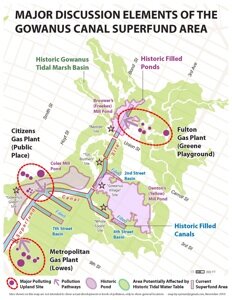First Meeting of EPA’s Gowanus CAG - A Good Start but ...
The EPA’s Gowanus CAG got off to a good start on the evening of Tuesday October 26th. Very good reports of the meeting are available on the CG CORD and Brooklyn Eagle websites, and photos and video of the event are available on the Pardon Me for Asking blogspot.
Given Gowanus by Design’s mission to provide a forum for planning and design information about the Canal, rather than repeating what has been so well documented by others we think GbD’s role should be to offer analysis of what we’re all learning at the CAG meetings.
With regard to the first CAG meeting, Walter Mugdan was straight forward in his description of what has happened to date and what is going to happen with the process. The short version is that the EPA’s Gowanus team is ahead of schedule. They’ve pushed very hard, and a preliminary assessment will be ready in January. Given what they know now, Walter speculated that the canal will be dredged and that the process will begin in three years inclusive of the time needed to develop the actual clean-up plan; and that the physical cleanup will be completed in approximately 2020 or 2022. That’s all good news, and is consistent with what Walter has described since the EPA first publicly announced they were considering the Gowanus for inclusion on the National Priorities List.
Now for the not so good news. The EPA is only responsible for cleaning up of the canal itself. Specifically, the mud on the bottom of the canal (and the sides, and the bulkheads, etc.). This mud is highly toxic, highly corrosive and in some areas contains 4.5% coal tar. Cleaning it up - getting it out of our community - is clearly a priority.
Unfortunately, the EPA Superfund process is not responsible for cleaning the water unless it’s a public health hazard. The (Federal) EPA through the 1972 Clean Water Act (CWA) enforces water quality standards throughout the country, and to maintain those standards occasionally sues local city agencies such as the New York City Department of Environmental Protection. The City under the direction of the State Department of Environmental Conservation (NYSDEC) is mandated with maintaining the Canal water quality and as a result the Gowanus Facilities Upgrade project is already underway. The City and State have pledged $175 million to enlarge the tunnel and to repair and update the flushing station. The NYCDEP has also issued $2.6 million in grants for innovative “Green Infrastructure” projects, including funding to the Gowanus Canal Conservancy for construction of storm water retention gardens along the Canal. While we believe the City is (finally) making its best effort to clean the Canal water, Walter acknowledged that the ultimate goals of the CWA - making public waterways fishable and swimmable - is not achievable in our lifetimes given that the entire lower Hudson Bay and all of its estuaries are polluted.
While we would all like to experience a swimmable and fishable Gowanus, a water quality level that is non-toxic and supportive of marine life is a more realistic and immediate goal. This would bring the Gowanus on par with the current state of the lower Hudson and East Rivers, especially once the Flushing Tunnel connection to the East River’s Buttermilk Channel is upgraded, effectively pumping cleaner water into the Canal.
The far more concerning aspect of Walter’s presentation is that the EPA will not be responsible for the clean up of the uplands, though it has the legal tools to declare them part of the Superfund site. Upland cleanup is currently the responsibility of local developers, regulated by the City laws, and under the guidance of the NYSDEC. Cleaning up the uplands is currently determined by State standards adjusted to the proposed use for the property. Our concern is that the source of the worst pollutants in the Canal is in fact the uplands since that’s where coal tar and other pollutants are seeping from.
This map above is based on what we feel is relevant information and what was presented at the meeting, and details three locations of prior gas plant sites that are heavily polluted with numerous toxins including coal tar. The tar migrates deep underground through buried marsh soils and is dispersed by tidally influenced streams and rain water seepage. Until the uplands are remediated toxic pollutants, including coal tar, will continue to seep into the canal.
We have to ask - is this “Canal only” Superfund remediation the best scenario for cleaning up the Canal area? Is it the best plan, or a compromise between the EPA, the City and developers? Are the City and developers the best parties to achieve a complete and thorough remediation of the Canal uplands after the City seriously considers residential development and playgrounds on polluted sites before the remediation studies of those sites were complete (notably Toll Brothers project which was actually approved!). Walter acknowledged that the EPA could take over clean up of the uplands if necessary. This is something that we as a community need to consider if cleanup “standards” for individual sites continue to allow toxins to migrate into the Canal.
Additionally, in reviewing the EPA map of the canal cleanup we note that several areas where the Canal has been illegally filled in are not currently set to be dredged and remediated. We need to press the EPA to expand their cleanup areas to include these portions of the Canal basin, notably the eastern leg under the Third Avenue bridges.


